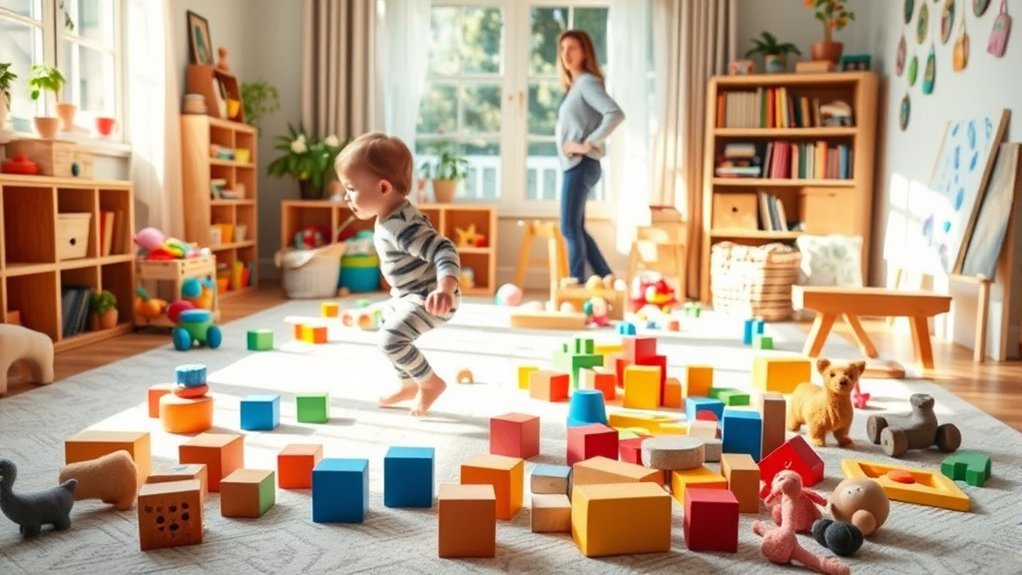Did you know that open-ended toys can greatly enhance a child’s problem-solving skills and creativity? However, safety concerns often overshadow their benefits. To truly maximize the potential of these toys, it’s vital to contemplate a few key prevention tips. From selecting age-appropriate items to establishing safe play practices, there are essential steps you can take. Understanding these can lead to a more enriching and secure play experience for your child.
Choosing Age-Appropriate Toys
When it comes to choosing age-appropriate toys, how can you guarantee that your selections truly foster development? First, consider your child’s developmental stage. Look for toys that challenge them without causing frustration. Open-ended toys, like building blocks or art supplies, encourage creativity and problem-solving. Check labels for age recommendations, but remember that children often develop at different rates.
Next, think about safety features. Toys without small parts are crucial for younger children. Engage your child during playtime; their interests can guide your purchases.
Finally, balance educational value with fun. Play is essential for learning, so choose toys that stimulate imagination while being enjoyable. By making thoughtful choices, you’ll support your child’s growth and keep playtime enriching.
Setting Up a Safe Play Environment
Creating a safe play environment is essential for your child’s well-being and development. Start by decluttering the play area to minimize tripping hazards.
Guarantee that all toys are age-appropriate and free from sharp edges or small parts that could pose a choking risk. Use soft rugs or mats to cushion any falls, and secure heavy furniture to the wall to prevent tipping.
Check for any harmful substances, like toxic paints or chemicals, and keep them out of reach. Additionally, establish clear boundaries for play areas to help your child understand where it’s safe to explore.
Regularly inspect toys for wear and tear, replacing any damaged items promptly. A well-organized, safe environment encourages creativity while keeping your child secure.
Encouraging Supervised Play
While open-ended toys promote creativity and independent thinking, encouraging supervised play guarantees your child engages with their toys safely and meaningfully.
Supervision allows you to guide play, helping your child explore their imagination while ensuring they understand the appropriate use of each toy. You can ask open-ended questions to stimulate their thinking and creativity, fostering deeper engagement.
Additionally, being present during playtime helps you identify any potential challenges or frustrations your child may face, allowing you to step in and provide support. This not only enhances their experience but also strengthens your bond.
Ultimately, supervised play cultivates a safe environment where your child can thrive, harnessing the full potential of their open-ended toys.
Regularly Inspecting Toys for Safety
Regularly inspecting toys for safety is essential to ensuring your child’s playtime remains enjoyable and hazard-free.
By taking the time to check toys, you can prevent accidents and keep your little one safe.
Here are three key steps to follow:
- Check for Wear and Tear: Look for signs of damage, such as broken parts or frayed edges, which could pose a risk.
- Ensure Cleanliness: Regularly clean toys to eliminate germs and dirt, especially if your child shares them with others.
- Verify Age Appropriateness: Make sure the toys are suitable for your child’s age to avoid choking hazards or other dangers.
Teaching Safe Play Practices
Teaching safe play practices is essential for fostering a secure play environment for your child. Start by setting clear rules about how to use open-ended toys, emphasizing gentle handling and sharing.
Demonstrate proper use of toys, showing what’s safe and what’s not. Encourage your child to express their feelings about playtime, helping them understand boundaries and respect for others.
Supervise playtime, especially with younger children, to guarantee they’re following safety guidelines. Discuss the importance of cleaning up to prevent tripping hazards.
Regularly remind your child to be aware of their surroundings during play. By instilling these habits early, you’re not just promoting safety; you’re also empowering your child to make smart choices in their play and beyond.
Frequently Asked Questions
What Are the Benefits of Open-Ended Toys for Child Development?
Open-ended toys foster creativity, critical thinking, and problem-solving skills in children. They encourage exploration and self-expression while developing fine motor skills. You’ll notice your child’s confidence grow as they invent new ways to play.
How Can I Encourage Creativity With Open-Ended Toys?
To encourage creativity with open-ended toys, you should provide diverse materials, let your child explore freely, ask open-ended questions, and celebrate their ideas. This approach fosters imagination and problem-solving skills while making playtime more engaging.
Are There Eco-Friendly Options for Open-Ended Toys?
You’ll find eco-friendly options like wooden blocks, organic cotton dolls, and recycled plastic building sets. Remember, “quality over quantity” applies here; these sustainable toys can spark creativity while being kinder to our planet.
Can Open-Ended Toys Be Used in Group Settings?
Yes, you can definitely use open-ended toys in group settings. They encourage collaboration, creativity, and communication among children, fostering teamwork while allowing each child to express their unique ideas in a shared environment.
How Do I Clean and Maintain Open-Ended Toys?
“An ounce of prevention’s worth a pound of cure.” To clean and maintain your open-ended toys, regularly wipe them with a damp cloth, use mild soap when needed, and guarantee they dry completely to prevent mold.
Conclusion
In your quest for creativity, it’s easy to overlook safety, but that’s ironically the first step to true exploration. By choosing age-appropriate toys, setting up a safe play area, and supervising playtime, you’re not stifling creativity; you’re enhancing it. Regular inspections and teaching safe practices guarantee that open-ended toys remain a source of joy, not a cause for concern. Remember, fostering imagination and safety isn’t just possible—it’s essential for a fun, enriching play experience.
